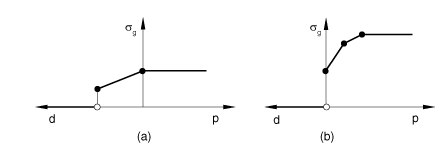Electrical contact properties | ||
| ||
ProductsAbaqus/StandardAbaqus/CAE
Including gap electrical conductance properties in a contact property definition
You can include electrical conductance properties in a contact property definition for surface-based contact.
Input File Usage
Use both of the following options:
SURFACE INTERACTION, NAME=name GAP ELECTRICAL CONDUCTANCE
Abaqus/CAE Usage
Interaction module: contact property editor: ![]()
Modeling electrical conductance between surfaces
Abaqus/Standard models the electrical current flowing between two surfaces as
where J is the electrical current density flowing across the interface from point A on one surface to point B on the other, and are the electrical potentials on opposite points on the surfaces, and is the gap electrical conductance. Point A corresponds to a node on the slave surface of the contact pair. Point B is the point of the master surface in contact with point A.
You can provide the electrical conductance directly or in user subroutine GAPELECTR.
Defining σg directly
When the gap electrical conductance is defined directly, Abaqus/Standard assumes that
where
is the average of the surface temperatures at A and B,
- d
is the clearance between A and B,
- p
is the contact pressure transmitted across the interface between A and B, and
is the average of any predefined field variables at A and B.
Defining gap electrical conductance as a function of clearance
You can create a table of data defining the dependence of on the variables listed above. The default in Abaqus is to make a function of the clearance, d. When is a function of gap clearance, d, the tabular data must start at zero clearance (closed gap) and define as a function of the clearance. The value of remains constant for clearances outside of the interval defined by the data points. If gap electrical conductance is not also defined as a function of contact pressure, will remain constant at the zero clearance value for all pressures, as shown in Figure 1(a).

Input File Usage
GAP ELECTRICAL CONDUCTANCE , ,
Abaqus/CAE Usage
Interaction module: contact property editor: ; Definition: Tabular; Use only clearance-dependency data
Defining gap electrical conductance as a function of contact pressure
You can define as a function of the contact pressure, p. When is a function of contact pressure at the interface, the tabular data must start at zero contact pressure (or, in the case of contact that can support a tensile force, the data point with the most negative pressure) and define as p increases. The value of remains constant for contact pressures outside of the interval defined by the data points. If gap electrical conductance is not also defined as a function of clearance, is zero for all positive values of clearance and discontinuous at zero clearance, as shown in Figure 1(b).
Input File Usage
GAP ELECTRICAL CONDUCTANCE, PRESSURE , ,
Abaqus/CAE Usage
Interaction module: contact property editor: ; Definition: Tabular; Use only pressure-dependency data
Gap electrical conductance as a function of both clearance and contact pressure
You can define to depend on both clearance and pressure. A discontinuity in is allowed at and . Once contact occurs, the conductance is always evaluated based on the portion of the curve that defines the pressure dependence. The gap electrical conductance, , remains constant for contact pressures outside of the interval defined by the data points. The pressure dependence of is extended into the negative pressure region even if no data points with negative pressure are included.
Input File Usage
Use both of the following options:
GAP ELECTRICAL CONDUCTANCE , , GAP ELECTRICAL CONDUCTANCE, PRESSURE , ,
Abaqus/CAE Usage
Interaction module: contact property editor: ; Definition: Tabular; Use both clearance- and pressure-dependency data
Defining gap electrical conductance to be a function of predefined field variables
The gap electrical conductance can be dependent on any number of predefined field variables, . By default, it is assumed that the electrical conductivity depends only on the surface separation and, possibly, on the average interface temperature.
Input File Usage
GAP ELECTRICAL CONDUCTANCE, DEPENDENCIES=n
Abaqus/CAE Usage
Interaction module: contact property editor: ; Definition: Tabular, Clearance Dependency and/or Pressure Dependency, Number of field variables: n
Defining σg using user subroutine GAPELECTR
When is defined in user subroutine GAPELECTR, there is greater flexibility in specifying the dependencies of than there is using direct tabular input. For example, it is no longer necessary to define as a function of the average of the two surfaces' temperatures or field variables:
Input File Usage
GAP ELECTRICAL CONDUCTANCE, USER
Abaqus/CAE Usage
Interaction module: contact property editor: ; Definition: User-defined
![]()
Modeling heat generated by electrical conduction between surfaces
Abaqus/Standard can include the effect of heat generated by electrical conduction between surfaces in a coupled thermal-electrical and a fully coupled thermal-electrical-structural analysis. By default, all dissipated electrical energy is converted to heat and distributed equally between the two surfaces. You can modify the fraction of electrical energy that is released as heat and the distribution between the two surfaces; see Modeling heat generated by nonthermal surface interactions for details.
![]()
Surface-based output variables for electrical contact property models
Abaqus/Standard provides the following output variables related to the electrical interaction of surfaces:
- ECD
Electric current per unit area leaving slave surface.
- ECDA
ECD multiplied by the area associated with the slave node.
- ECDT
Time integrated ECD.
- ECDTA
Time integrated ECDA.
The values of these variables are always given at the nodes of the slave surface. They can be requested as surface output to the data, results, or output database files (see Surface output from Abaqus/Standard and Surface output in Abaqus/Standard and Abaqus/Explicit for details).
Contour plots of these variables can also be displayed in the Visualization module of Abaqus/CAE (Abaqus/Viewer).